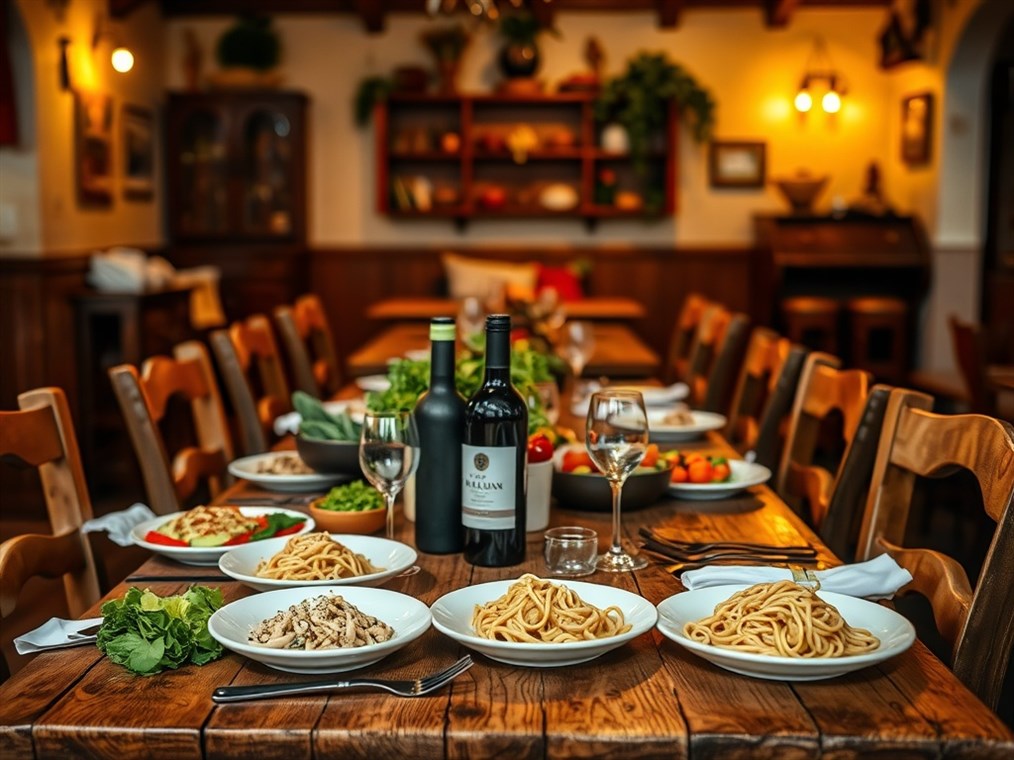Eating Like an Italian: Ditch the Tourist Traps and Embrace the Table
Let’s be honest, Italian food is more than just fuel. It’s practically a national sport, a social event, and woven into the very fabric of Italian life. So, whether you’re squeezing into a bustling trattoria or lucky enough to score an invite to an Italian family’s home, knowing a little about dining etiquette can seriously boost your experience – and show you’re not just another tourist.
Forget wolfing down your food; Italian meals are a marathon, not a sprint. The traditional structure is a multi-course affair, a delicious journey designed to be savored. Think of it as a culinary roadmap:
- Aperitivo: This is where things kick off – a pre-meal drink and some nibbles. Olives, nuts, maybe a little cheese. It’s all about waking up your taste buds.
- Antipasto: Now we’re talking! Appetizers galore, usually cold cuts like prosciutto, cheeses, or bruschetta. Think of it as the opening act.
- Primo: The first act itself! Usually pasta, risotto, soup, or something else deliciously starchy. Important note: pasta dishes are generally light on the meat.
- Secondo: The main event! This is where the meat or fish takes center stage.
- Contorno: A supporting role for the secondo. Veggies or salad, often. Fun fact: salads usually come after the main course, not before.
- Formaggi e Frutta: A little cheese and fruit to cleanse the palate.
- Dolce: Sweet ending time! Tiramisu, panna cotta, gelato… need I say more?
- Caffè: Espresso to help you digest all that deliciousness. Milk is usually a no-go at this point.
- Digestivo: A little something to really settle your stomach – amaro or limoncello, perhaps?
Now, before you panic, you don’t have to order every single thing on that list. A typical meal might be an antipasto, followed by either a primo or secondo with a contorno. The key is to relax and enjoy.
Table Manners 101: Dos and Don’ts for Dining Like a Pro
- Hold your horses! Don’t dig in until everyone’s been served. The host will often say “Buon appetito!” – that’s your cue.
- Hands up! Keep your hands visible, wrists resting on the table’s edge. No laps allowed.
- Fork and knife finesse: Italians usually stick with the same fork and knife throughout the meal. The knife stays in your right hand, the fork in your left. When you’re done, lay them parallel on the right side of your plate, fork tines down.
- Pasta perfection: No cutting spaghetti! Twirl it around your fork, using the side of your plate for leverage. And please, no slurping.
- Bread basics: Bread is for sopping up that delicious sauce (“fare la scarpetta“). It’s a compliment to the chef, trust me.
- Parmesan patrol: Don’t just sprinkle Parmesan on everything! It’s a no-no for seafood dishes. If the waiter doesn’t offer it, there’s probably a good reason.
- Cappuccino curfew: Milky coffees are morning drinks only! Stick to espresso after a meal.
- Savor each flavor: Italians believe in enjoying each flavor in the meal and not mixing courses.
- Take your time: Meals are meant to be enjoyed and savored. Don’t rush through your meal.
- Eat Local: Opt for local and seasonal ingredients .
Tipping: The Lowdown
Tipping in Italy isn’t the same as in the States. It’s less common, less expected. Here’s the deal:
- Check the bill: Look for “coperto” (cover charge) or “servizio” (service charge). If it’s there (usually 10-15%), you don’t need to tip extra.
- Rounding up: If there’s no service charge, just round up the bill or leave a small tip (€1-€2 per person).
- Exceptional service: For truly outstanding service, a 5-10% tip is fine, especially in fancy restaurants.
- Bars and cafes: No tip needed, unless you get table service. Then, a few coins (€0.50-€1) is nice.
- Other services: Tip porters €1-€2 per bag. Housekeeping? €1-€2 per day. Tour guides usually get around €20 for a half-day tour, €50 for a full day.
A Few Extra Tips
- Reservations are your friend: Especially during tourist season.
- Dietary needs? Speak up! Italian cuisine is pretty flexible. Vegan options are becoming more common, and lots of dishes can be tweaked.
- Dinner time is late: Italians eat dinner later, usually around 8:00 PM or later.
- Sharing is caring… sometimes: Sharing antipasti is cool, but Italians usually get their own pasta and main courses.
- Business talk? Maybe not: Avoid shop talk during meals unless your Italian colleagues bring it up.
So, there you have it! Armed with this knowledge, you’re ready to dive into the Italian dining scene like a pro. Buon appetito! Go forth, eat well, and enjoy the experience!

